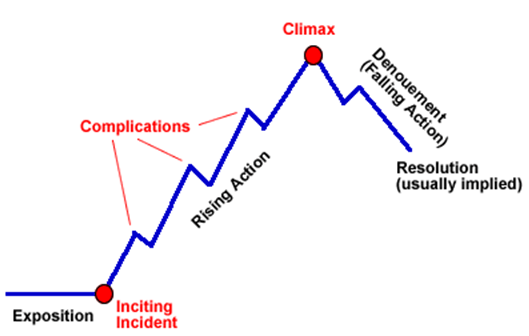Static characters do NOT do this in the course of a story, 'cause like you know, they're static!
What is CHANGE?
Narration often follows a structure which includes the exposition, rising action, climax, falling action, and resolution.
What is PLOT STRUCTURE?
This type of literary device provides readers with a clue as to what may happen later; it is only at the end that they will discover its truth.
What is FORESHADOWING?
In a participant point of view, the narrator tells the story using this "person," (they may or may not be the main character) using pronouns like "I, me, we, us, etc."
What is FIRST PERSON?
This short story term means not only physical location, but historical context and time.
What is setting?
"The fire burst the house open and let it slam flat down, puffing out skirts of spark and smoke."
(two answers)
What is personification and imagery?
This type of character has several traits and a complex personality; they are generally dynamic.
What is a round character?
The part of the story where we are introduced to the main character(s), conflict, and setting.
What is EXPOSITION?
This literary device represents something deeper in the story that stands for something else and also supports the story's theme.
What is a symbol?

In this point of view, the narrator "knows all"--they can relate both thoughts and deeds of ALL the characters.
What is third person omniscient?:max_bytes(150000):strip_icc()/third-person-omniscient-point-of-view-1277125-v4-5b87078946e0fb0025390fa6.png)
"The house was an altar with ten thousand attendants, big, small, servicing, attending, in choirs. But the gods had gone away, and the ritual of the religion continued senselessly, uselessly."
(two answers)
What is a metaphor and imagery?
"At eight-thirty the eggs were shriveled and the toast was like stone."
(two answers)
What is imagery and simile?
This relatively simple type of character generally has only one trait; they are often a stereotype.
What is a FLAT character?
In plot, this is when everything changes for the protagonist - either for good or for bad -- often where the conflict of the story is solved.
What is the climax?

This literary device does not just appeal to our sense of sight--it can be an appeal to any of the five senses.
What is IMAGERY?
Sometimes a third-person narrator does not enter characters' minds; they only relate what they see and hear.
What is third person limited point of view?
When a reader asks, "What's a universal truth about humans or human nature in this story?" they are attempting to discover this.
What is theme?
"The fire burned on the stone hearth and the cigar fell away into a mound of quiet ash on its tray. The empty chairs faced each other between the silent walls, and the music played."
(two answers)
What is imagery and personification.
Information (STEAL - character's Speech, Thoughts, Effect on others, Actions, or Looks) that an author gives us.
What is INDIRECT characterization?
In plot, these events give rise to this literary term (two words).
What is RISING ACTION?
When an author exaggerates to emphasize a point.
What is a HYPERBOLE?
"I ain't gonna let you take that quilt from Maggie," I said. "She's gonna put it to 'everyday' use!"
What is first person point of view?
When we know something that other characters in the story don't know.
Example: Before any of the other characters know, we know that Miss Strangeworth is the author of the nasty letters to townsfolk.
What is dramatic irony?
What is the theme of "There Will Come Soft Rains"?
What is "technology can be useful, but it can also be deadly."
A character who only serves as a contrast or opposite to the protagonist or main character.
What is the ANTAGONIST?
This word is often the reason that characters do / say the things that they do / say and it's the "why" of a story.
What is MOTIVATION?
When an author refers to another person, place, or event in order to make a comparison.
What is an ALLUSION?
This 3rd person point of view sometimes uses a "stream-of-consciousness" narration but limits the "all knowing" capability to only one or just a few characters.
What is third person limited?
A contrast between what the reader or character(s) expect and what actually happens.
Example: Harrison expects to be emperor, but is shot down by the H.C. General.
What is situational irony?
"Robins will wear their feathery fire,
Whistling their whims on a low fence-wire;
And not one will know of the war, not one
Will care at last when it's done."
(three answers)
What is imagery, personification, and verbal irony.